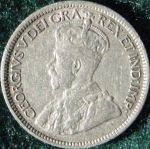The U.S. eliminated silver in their business strikes (coins produced for circulation) after 1964 but Canada kept silver in their business (a.k.a circulation) strikes until 1967 and into 1968 for some. The degree of silver fineness in U.S. business strikes didn't exceeded 90 percent (coin silver) while Canada maintained a silver fineness of 92.5 (sterling silver) until 1920. By keeping your eyes open for Canadian coins while at garage sales, flea markets or local coin shows, you may be able to find deals from sellers who either aren't aware of what they have or they simply want to sell because these coins are not big sellers like their other stock.
Because Canada is part of the British Commonwealth, Canadian silver coins have the image of the ruling British monarch on the obverse. So the Canadian junk silver coins you are most likely to see are the 80 percent silver coins bearing the image of Queen Elizabeth II (1953 to 1967), King George VI (1937-1952) or King George V (1920-1936). Here are their circulated silver content details...
Silver Dime(1920-1967): Silver Content=.0585 Troy ounce (.0600 uncirculated)
Silver Quarter(1920-1967): Silver Content=.1463 Troy ounce (.1500 uncirculated)
Silver Half(1920-1967): Silver Content=.2925 Troy ounce (.3000 uncirculated)
Silver Dollar (1935-1967): Silver content=.600 Troy ounce.
Due to a significant increase in the price of silver, in 1967 the Royal Canadian Mint changed the silver content of the ten-cent piece and twenty-five cent piece from 80 to 50 percent silver mid-year. Unfortunately, there is no practical way of determining which coins contain 50 percent silver and which contain 80 percent silver (what were they thinking?). For your information, a 50% silver dime contains .0375 troy ounces of silver and a 50% quarter .0937 troy ounces. No silver half-dollars or dollars were minted for circulation after 1967. In mid-1968, silver was removed from all business/circulation strike Canadian coins.

If you are lucky enough to come across Canadian silver coins dated earlier than 1920, these contain the higher silver content of 92.5 percent. If circulated, they are still considered junk silver but there is nothing "junk" about them. Here's a nice little coin I bought from a local coin dealer for one U.S. dollar. It is a 1917 King George V (he reigned from 1911-1936) sterling silver dime. It contains approximately .0690 troy ounces of silver uncirculated (this one a little less as it has been lightly circulated). With a spot silver price of $15, this coin (uncirculated) would have an intrinsic value of $1.04. Total mintage for this coin was 5,011,988 which is one of the higher mintages for sterling silver dimes. I was able to pick up a few others at a price less than their current book value. Here is some basic information on these coins...
Silver Canadian Nickel(1858-1919): Silver Content=.0347 Troy ounces*
Silver Canadian Dime(1858-1919): Silver Content=.0690 Troy ounces*
Silver Canadian Twenty-Cent Coin(1858): Silver Content=.1382 Troy ounces*
Silver Canadian Quarter(1870-1919): Silver Content=.1730 Troy ounces*
Silver Canadian Half-Dollar(1870-1919): Silver Content=.3456 Troy ounces*
*The silver content for the above coins are for uncirculated coins. Circulated coins have a slightly lower silver content due to their wear in daily commerce.
I want to mention another silver coin I purchased recently that is truely a one-off silver investment - a Mardi Gras silver doubloon. This one is a .999 silver coin that contains more silver than an uncirculated Peace or Morgan silver dollar. You can see pictures and details of this unique coin at Doubloon on my silver investing
web site.
In closing this post, (and as stated at the beginning), the information on Canadian silver coins is basic but may be enough to get you started. Especially if you have passed on opportunities to buy silver Canadian coins in the past because you lacked the knowledge. There is much more to Canadian silver coins than the brief descriptions given above. To become a savvy investor of Canadian silver coins, I recommend you invest in one or more books on the subject. If nothing else, you can preview the first few chapters of my Canadian Coin book for free. You will find it here.
Thanks for reading. Keep the faith.
John Ausiman


